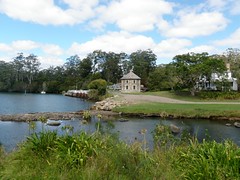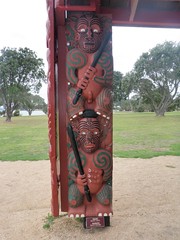So I never thought I'd say it, but I feel like an old timer in New Zealand. Even by American standards, everything here is very young. During our trip to the Bay of Islands, we visited Kerikeri near Waitangi which boasts the "oldest stone building in New Zealand." Now given the otherwise very English feel to so much of this country -- crumpets, biscuits, scones and tea come to mind immediately -- we anticipated a truly old building. The Stone Store, however, was built in the 1830s. My best friends in Philadelphia lived in a house about 50 years older than that so it's hard for me to think of this quaint little store as the "oldest" anything. Perhaps the single most important treaty between the native people and the white settlers was signed at Waitangi in 1840 during the administration of U.S. President Martin Van Buren and just about when that Englishman forever changed architecture with the invention of the blue print. Even native culture here is young by American and Mexican standards. Last summer, we visited villages dating 2,500 to 3,000 years old in the American Southwest. We went to a museum in La Paz with artifacts dating nearly 20,000 years. The wane in which the Māori people arrived on the islands, however, are only about 1,000 years old. And while we still have a lot to learn and will continue to research, so far Mera's research suggests there is no evidence for humans coming down here any earlier.
Which makes New Zealand very young, and it makes me wonder what she'll be when she grows up. A modern industrialized nation with a relatively strong central, democratic government leaps onto the world stage essentially at the beginning of the Information Age. New Zealand is only now stretching her collective muscle towards being separate and distinct from her domineering imperial mother England, and her loud, brash physical neighbor Australia. It's fascinating listening to the conversation from the inside as New Zealanders debate how, why and when this country should differentiate its political voice on issues of global import. What does this country represent? What are its major sports? Its industrial specialties? When is New Zealand the "go to" country when you want a representative of a particular perspective on an environmental or economic or human rights issue?
 I can't answer these questions, but what's probably more interesting is that I doubt there is an honest Kiwi in the entire country who can either. Fundamentally, New Zealand hasn't decided these questions yet for itself. This is a country that, while not in any danger of the violent overthrow of its government, nevertheless is seriously considering the adoption a new flag.* The current New Zealand flag is royal blue with the British Union jack in one corner and the Southern Cross. You can see why this flag is a bit problematic. Clearly, it's derivative. Pretty much all of us former Brit colonies have eventually chucked the Union Jack.
I can't answer these questions, but what's probably more interesting is that I doubt there is an honest Kiwi in the entire country who can either. Fundamentally, New Zealand hasn't decided these questions yet for itself. This is a country that, while not in any danger of the violent overthrow of its government, nevertheless is seriously considering the adoption a new flag.* The current New Zealand flag is royal blue with the British Union jack in one corner and the Southern Cross. You can see why this flag is a bit problematic. Clearly, it's derivative. Pretty much all of us former Brit colonies have eventually chucked the Union Jack.  There are several proposed flags, the most predominant being that of the United Tribes of New Zealand. It is white with a modified Southern Cross and the black and red bands common to Māori art. It's historical use during the Treaty of Waitangi to represent the tribes has made this the flag of choice for Māori.
There are several proposed flags, the most predominant being that of the United Tribes of New Zealand. It is white with a modified Southern Cross and the black and red bands common to Māori art. It's historical use during the Treaty of Waitangi to represent the tribes has made this the flag of choice for Māori.  Others say ditch the entire colonial and tribal controversy and strike out in a whole new direction with a radical new look. Many flags have been proposed but the most popular seem to use as a central theme the silver fern leaf.
Others say ditch the entire colonial and tribal controversy and strike out in a whole new direction with a radical new look. Many flags have been proposed but the most popular seem to use as a central theme the silver fern leaf.It's like rolling back time and getting a whiff of what it must have been like in the United States when these issues were discussed. And at the same time, this conversation is taking place in a time so economically, scientifically, and sociologically different that the discussion quite literally involves all four million Kiwis simultaneously rather than just a few white old men in major urban centers isolated from the opinions of the governed population.
I want to root for these people. Like the Chinese, they get to skip entire phases of industrialization. They get to pick and choose from global examples of what works and what doesn't work in finance, law, health care, and education. The population is small enough that a few people can change the entire country. At the same time, the population is small enough that God help them a few people can really screw things up. Management matters and particularly so in a country like New Zealand where they can't really afford to make major mistakes. When they make a major mistake -- for example in the 1980's someone screwed up absolutely royally regarding building codes -- the entire country suffers. I mean every single last person in the country, including my family, are going to have to deal with the fact that 25 years ago a lot of buildings were built to very crappy standards and are now quite literally falling down on our heads.
All of this interests my children not at all and my husband very little. I, however, find it fascinating and have been filling my ears with Kiwi news and social media. While the girls learn how to say 'whut ehva' and DrC relearns how to remove cataracts, I'm studying the political economy of the antipodes. And doing the laundry.
* Now before you get all smug and remind that the U.S. flag changed a mere 50 some odd years ago when Alaska and Hawaii were made states, it's probably more fair to say that the U.S. flag hasn't fundamentally changed in basic design since 1776 since all we've been doing is adding more and more stars.



5 comments:
Bore me??? Not a chance. One of the main reasons I want to cruise is to experience as many cultures and peoples and traditions as I can and to finally have time to think and explore instead of working my tush off day after day to fund my conservative boss' playthings. Keep it coming!
Deb
S/V Nomad
www.theretirementproject.blogspot.com
Does the Confederate Flag not count? It seems relevant in this context.
You know, JP, that's an interesting question. Personally, I don't take the movement to legitimize the Confederate Flag seriously. True, during war it was relevant, but today? That may be a sign of my west coast myopia, though. Good call.
Great post, I love learning about different cultures, their history and social aspects. Keep this sort of stuff coming.
what is the signifigance of the silver fern?
I always associate New Zealand with all things woolen. Sheep outnumber people, and Anne Field rules! One person's rock star...
Post a Comment